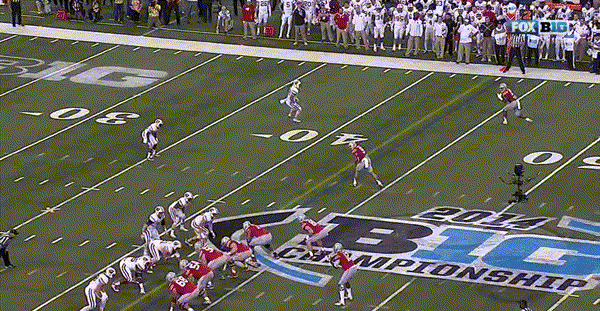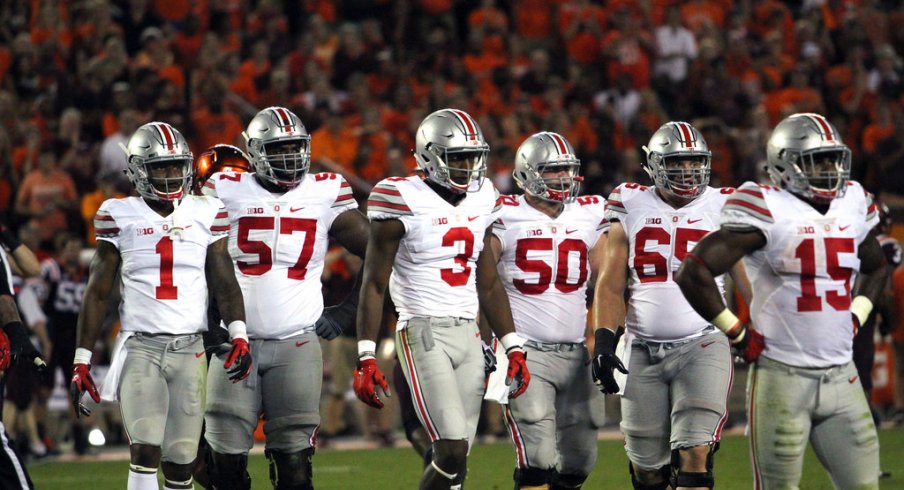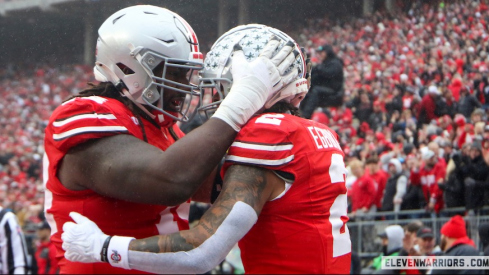“If you win the turnover battle and the explosive play battle in the same game, you win that game 98 percent of the time."
Those are the words of Houston head coach Tom Herman on a recent episode of Podcast Ain't Played Nobody, in which the former Ohio State offensive coordinator discussed the value of advanced statistics. But while the conversation centered on how this thinking affects the way Herman leads his current program, it's hard not to apply it to his former team as well.
The timing of the interview couldn't have been more apt, as one of the podcast's hosts, Bill Connelly, recently published his preview of the 2016 Buckeyes and laid out a possible explanation for why the 2015 team failed to live up to its championship expectations. While the offense, led by NFL-caliber talents like Ezekiel Elliott, Braxton Miller, and Michael Thomas, was the 10th-most efficient unit in the nation, it ranked only 73rd in creating explosive plays. By comparison, OSU ranked 3rd in efficiency and 21st in explosiveness during the 2014 campaign.
While there is no uniform method to measure 'explosive plays' (Herman defines them as runs of 12 yards or more and passes of 19 or more), a quick look at the stats from the past two seasons shows a clear difference in Ohio State's ability to create big plays:
| Season | Runs of 10+ Yds | Runs of 20+ Yds | PAsses of 15+ Yds | PAsses of 25+ YDs |
|---|---|---|---|---|
| 2014 | 138 | 36 | 85 | 42 |
| 2015 | 97 | 24 | 55 | 23 |
It should be noted that the Buckeyes played two more games in 2014 than in 2015, which roughly explains the difference between the rushing totals. The remaining disparity on the ground was due to the rotation at quarterback between Cardale Jones and J.T. Barrett during the first half of last season. After tallying 36 runs of 10 yards or more the year prior, Barrett registered only 21 while splitting time in 2015.
However, the downturn in production through the air in 2015 can't simply be blamed on fewer opportunities. Indeed, when looking at yards-per-attempt in both categories, the story comes better into focus:
| Season | Rush Attempts | rush Yds/attempt | PAss Attempts | pass Yds/attempt | Completion % |
|---|---|---|---|---|---|
| 2014 | 690 | 5.75 | 409 | 9.1 | 63.6 |
| 2015 | 567 | 5.62 | 325 | 7.6 | 62.8 |
These results will likely come as no surprise to followers of Buckeye football, as the team's aerial inconsistencies have been well documented. Many blamed the Jones-Barrett carousel for this as well, but the real culprit was most likely the absence of Devin Smith as a deep threat.

When looking at the OSU starting receivers over the past two seasons, Thomas and Jalin Marshall virtually replicated their production from year to year, while Miller was unable to provide the same production down the field as Smith.
| Player | Catches | Rec Yds | REC TDs | Catches of 25+ Yds |
|---|---|---|---|---|
| Devin Smith | 33 | 931 | 12 | 18 |
| Michael Thomas | 54 | 799 | 9 | 6 |
| Jalin Marshall | 38 | 499 | 6 | 7 |
| Player | Catches | Rec Yds | REC TDs | Catches of 25+ Yds |
|---|---|---|---|---|
| Michael Thomas | 56 | 781 | 9 | 6 |
| Jalin Marshall | 36 | 477 | 5 | 7 |
| Braxton Miller | 26 | 341 | 3 | 4 |
While some may view the lack of a real deep threat as the cause for the Buckeyes' lack of success through the air, the Buckeyes rarely tried to attack downfield in 2015. After a dominant display against Virginia Tech in the season opener, the OSU offense grew ever-more conservative after failing to connect on early deep balls against Hawaii and Northern Illinois.
At the time, no one could blame the coaching staff for leaning more heavily on Elliott and the efficient running game, but the effect of these play calls likely wasn't felt until later in the season. Just as he had the year before, Thomas' biggest gains only came when the physical receiver broke a tackle after making a short catch and simply out-running the defense, meaning the explosive plays only came when the opponent made a mistake.
Meanwhile, Miller was actually most productive as a deep threat, yet was given very few chances to do so. Instead, his contributions were limited to direct snaps, jet sweeps, and other calls designed to pick up a few yards with the hopes that his shiftiness in the open field would lead to a missed tackle and subsequent big gain.
As the season progressed, the efficient running game not only became the core element of Buckeye game plans, it came to dominate them. With the exception of a late-season matchup with an overmatched Rutgers squad, Barrett attempted few downfield throws.
By the time Michigan State came to town in late November, the offense had still yet to build any rhythm in their downfield passing attack, and the Spartans knew it. By winning the battle up front that day, MSU was able to hold the normally efficient Buckeye running game in check, and there was no downfield aerial threat to stretch the defense as Smith had done the year prior in East Lansing. Although Ohio State won the turnover battle that day, they generated only one explosive play (a 16-yard reception from Marshall) and lost that battle to what many would normally consider an underwhelming performance from the opposing offense.
Looking forward to this fall, the Buckeyes must identify a reliable deep threat early if they hope to avoid similar performances. After making some impressive plays down the field in the 2015 CFP Championship game, Corey Smith looks the most likely to fill this role, although a young player may step up during these next few weeks of fall camp.

But building an explosive attack has far more to do with the play-calling than the players themselves. If Herman's former colleagues hope to contend for championships this fall, they must re-think their dependence on building an efficient offense and be willing to take more chances through the air.


